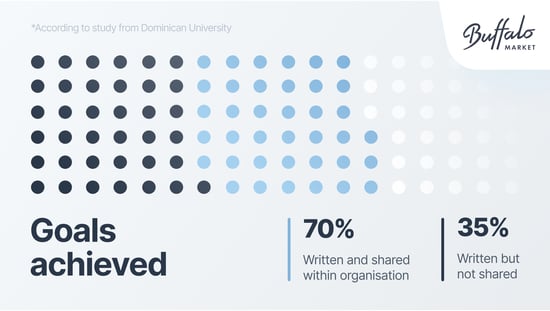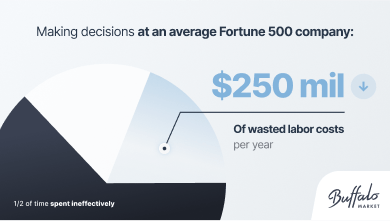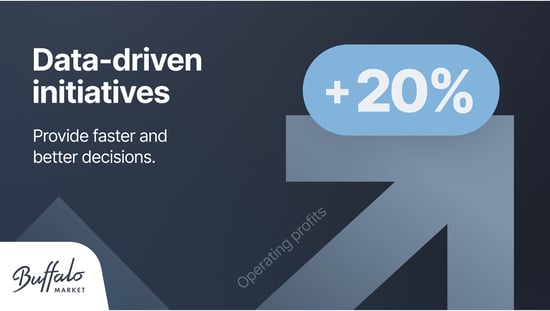Buffalo Market Business Philosophy & Formula 1: Driving Success
Business Philosophy for Peak Performance
Both Buffalo Market and Formula 1 are known to employ a human-centric attitude that delivers consistent results at lightning speed.
From the drivers in the limelight to the engineers and pit crews working diligently behind the scenes, Formula 1 teams offer prime examples of excellence, innovation, and evolution in the industry and inspire how we do things at Buffalo Market—especially our lightning-fast team of "Ninja" merchandisers.
The business book, Performance at the Limit analyzes the company philosophy of Formula 1 to see what could be learned and applied across other industries. The twelve lessons outlined in the book parallel many of the same principles Buffalo Market uses every day.
These twelve lessons provide valuable insights into how the team at Buffalo Market rethinks its structure, fosters culture, and leverages our greatest asset—our people.
-
Maintain Open and Honest Communication
This tenet might seem like a no-brainer to anyone with experience in tech workplaces. When the authors of Performance at the Limit conducted their 2006 research, nearly every respondent agreed that one of the most important keys to success in the organization was open and honest communication company-wide.
Tech CEOs seem to have caught on since the book was published. Nearly gone are the days of rigid hierarchical structure with employees too scared to speak their minds and so go unseen and unheard. Workplaces know now that you can’t have a healthy company culture without every single person on your team sharing mutual respect and trust—something you can only establish with open lines of communication between everyone involved.
One famous example (that arguably led the charge for this principle in the tech industry) is the online shoe retailer Zappos. In fact, its sixth Core Value for company culture is titled “Build Open and Honest Relationships with Communication”:
“Fundamentally, Zappos believes that openness and honesty are two ingredients that fuel healthy, trusting relationships and emotional connections. Remember: Communication encompasses a whole lot of actions, including verbal and nonverbal exchanges. You may give a good speech, but are you a good listener? Can you write with the best of them, but fail to read between the lines? At Zappos, we embrace diversity in thoughts, opinions and experiences. Yet every single day Zapponians strive to build even better open and honest communication in everything we do.”
Zappos is famous for its outstanding company culture—thanks in no small part to its belief in the power of open communication. Teams that feel they can communicate honestly with their peers and company leadership will experience a sense of trust and perform better at their jobs.
-
Isolate the problem, not the person: The no-blame culture.
Speaking with WilliamsF1 then Team Manager Dickie Stanford, the book’s authors came to understand the organization’s emphasis on getting to the root cause of a problem rather than finding someone to take the blame. Apart from being necessary to an overall culture of happiness within your company, this attitude also helps streamline problem-solving. The idea is that when failures are shared, they’re more likely to be understood and solved. This is another principle you frequently hear in tech but isn’t as common as one might hope. Repressing the urge to place blame doesn’t come very naturally to humans and can be hard to pull off at scale, but fostering a culture of blamelessness is ultimately good for your bottom line.
The fittingly-named software company, Blameless, shares why the company has chosen to put its money where its mouth is and encourage a culture of collaboration over placing individual blame:
“Research shows that systemic failure is caused by complex and non-linear conditions. So, to discover the full story of an incident, we need to draw out the narratives and circumstances leading up to it…Yes, they draw out the technical barriers causing an incident. But they also provide insights on the systemic factors that contribute to failure. By adopting a culture of true blamelessness, teams will adapt to unforeseen circumstances. while engaging in constant learning to improve systematic complexities.”
Here, Blameless explains that by viewing failures from a holistic perspective, rather than scapegoating an individual, you get a better understanding of system issues at the root cause of the problem and can solve it more effectively.
-
Build the organization around informal processes, networks, and relationships.
Yet another ideological framework Formula 1 adopted early on is something we now see applied often in the tech world— the loosening of hierarchical structures. Nowadays, many successful tech companies allow for more informal relationships between colleagues and processes. Letting some bureaucratic boundaries blur a little, it turns out, lets both teams and individuals better reach their full potential. A dated but relevant 2007 case study published by the management consulting firm, McKinsey, revealed the perks of dismantling walls and improving connections in the workplace:
“Surveys showed that the agency’s efforts had not only facilitated the flow of information but also promoted cultural change. Network participants felt far more energized in collaborations with colleagues, an index measuring overall progress toward a more decentralized and flexible culture rose by 18 percent, and the gap between the perceived and desired work environment had shrunk substantially in the eyes of both management and employees.”
Unsurprisingly, a workplace built around fostering connections between employees benefits from out-of-the-box thinking, streamlined processes, and a general sense of wellbeing across the organization. It’s no wonder that more and more tech companies have adopted informal structures as time has gone on

-
Alignment of goals between individuals, teams, and partners
None of the principles in this list would have much effect if those engaged in them weren’t all working toward the same goal. That’s why Frank Williams, founder of Williams Formula 1, was known to ask, “How will it make the car go faster?” each time he was asked to approve spending. That simple adherence to a singular principle helped F1 along its trajectory at all levels of the organization. When members of a team understand why they’re doing what they’re doing, decision-making becomes easier and post-decision assessment becomes clearer.
Tech companies today are familiar with the concept of goal-alignment using “OKRs” (Objectives and Key Results). OKRs align teams by establishing a clear goal and agreed-upon metrics to measure progress. Citing a study from Dominican University, former tech CEO Zorian Rotenburg writes:
“Written, shared goals are more likely to be achieved than those that aren’t shared or made visible to the company. Dominican University research shows 70% of written, shared goals are accomplished, compared to just 35% that aren’t shared. OKRs allow the entire company to see the most important corporate priorities so everyone focuses on what really matters.”
No doubt much has changed since Frank Wiliams’ day, but the idea of getting your team aligned behind a singular, achievable goal remains as important as ever.

-
Focus, Focus, Focus
Much like goal alignment, establishing focus is paramount to keeping your business on track (quite literally in the case of Formula 1!). Organizations with a tight focus on their business strategy can almost always count on success. In its report on Amazon, Business Research Methodology writes that the tech giant owes its growth to training its focus on a simple business strategy—always offer that which will never go out of demand:
“The founder and former CEO Jeff Bezos prefers to base business strategy on things that do not change. Specifically, consumers will always want low prices, variety and speedy delivery of their orders. Amazon focuses on these facts via effective integration of information technology into various business processes.”
By ensuring its service offers the lowest prices, widest variety, and fastest delivery, Amazon will always appeal to online shoppers. As long as the retail behemoth focuses on those three things, you can count on its continued success.

-
Make quick decisions and learn from the results
Formula 1 teams are constantly learning on their feet. Each success or failure becomes an opportunity to improve or fine-tune. The same is certainly true in tech. Like making adjustments to a racecar, the tech industry is always experimenting with changes, whether they be iterative or monumental.
You shouldn’t devote too much time to making sure a course of action is correct, though. By making snap decisions, you have the chance to stay ahead of the competition and continually innovate. Agonizing over each decision doesn’t just sap time. Evidence suggests that it doesn’t even lead to more effective decision-making! A 2019 survey from McKinsey and Company revealed that:
“On average, respondents spend 37 percent of their time making decisions, and more than half of this time was thought to be spent ineffectively. For managers at an average Fortune 500 company, this could translate into more than 530,000 days of lost working time and roughly $250 million of wasted labor costs per year.”
The lesson for tech companies here is that while spending time making decisions might feel like the right thing, you might be hindering yourself in reality. As long as you take care to learn from every decision you make, you can afford to make quick ones.

-
The real gains come at the boundaries
The authors of Performance at the Limit observed that the real successes of Formula 1 came not from the actions of any one person or department but from those moments when margins collide—that the team could achieve the greatest gains through integration.
When you eliminate silos within your organization, you remove barriers that stifle communication and can get in the way of accomplishing shared goals. One exceptional example of this principle is the German chemicals company BASF. Using a supply chain system of “Verbund Sites,” BASF integrates nearly every part of the business, facilitating efficient use (and reuse) of resources and expertise. From the BASF website:
“The Verbund system creates efficient value chains that extend from basic chemicals right through to high-value-added products…the by-products of one plant can be used as the starting materials of another. In this system, chemical processes consume less energy, produce higher product yields and conserve resources. “
BASF also applies the Verbund system to its technology, marketing, and data departments for an organization that’s intimately connected across all channels. It’s well known that tech companies with too many silos will become sluggish and struggle to compete. By integrating the departments within your organization, you’ll make the most efficient use of your resources.
-
Be realistic about what can be achieved
Jenkins and his coauthors also observed the importance of setting realistic goals. In the fast-paced world of Formula 1, the constant presence of change can lead to fatigue. By setting reasonable limits on what can be expected from a given course of action, you lessen the risk of fatigue and increase the chances of success.
Most everyone working in tech (and many other industries) is already familiar with the concept of realistic goal-setting, reflected in the ubiquitous acronym: SMART—Specific, Measurable, Attainable, Relevant, and Time-Bound. By ensuring your goals satisfy SMART criteria, you contain them within reality, which can help you organize the steps necessary to achieve them.
In its blog on SMART goals, Hubspot puts it this way:
“If your goals are abstract, if you don't know what it will take to achieve success, or if you don't give yourself a deadline to complete steps, you may lose focus and fall short of what you want to accomplish.”
Setting goals with concrete, realistic expectations keeps you grounded and makes the steps to getting there more solid and easier to achieve. What could be smarter than that?
-
Never believe you can keep winning
In its ninth lesson, the book discusses the dangers of the Icarus Paradox, a principle in business concerning the pitfalls of perceived infallibility, which can lead to unforeseen failures down the line. In an argument for overcoming the paradox, the authors recall the case of Ferrari, a company that, despite consistent successes, always keeps the pressure on and challenges itself to push ahead—even when leading the pack.
Companies throughout history have seen themselves fall victim to the Icarus Paradox. One such example in recent memory is Netflix. The Guardian reports that in the first quarter of 2022, shares in Netflix dropped more than 30%, the service lost over 200,000 subscribers, and it was expected to lose 2 million more in the coming months. This came shortly after the service increased its monthly subscription fee.
The news was met with no shortage of speculation as to the cause. Still, we know that the company had experienced a large increase in subscribers over the two years prior, as more people found themselves stuck at home during the Covid-19 pandemic. At the same time, competitors like Disney+, HBO Max, and Peacock entered the streaming marketplace.
Had Netflix not been blinded by its past successes, it might have had the foresight not to raise its prices as pandemic-related restrictions ended, and other streaming options became more available. Why should users agree to pay a premium for a service when movie theaters are reopened, and other high-quality streaming platforms launch every day?

-
Leaders exist at all levels of the organization
Something Jenkins and his colleagues also noticed about Formula 1’s culture was that at every level, individuals were encouraged to step up to the plate and lead whenever the opportunity arose. Giving its team members authority to take charge encourages engagement and allows Formula 1 to move and act quickly—a necessity in the racing game.
It’s easy to see why a lot of tech companies fall short in this regard. Many people in leadership positions are reluctant to dispense with their authority. The evidence suggests, though, that organizations with engaged, empowered employees stand to gain quite a bit. According to a 2017 report on effective employee engagement in the workplace from Walden Unversity:
“Leaders who implement employee engagement strategies noted (a) higher levels of employee engagement (Blattner & Walter, 2015); (b) improved customer satisfaction, productivity, and profit (Bowen, 2016); and, (c) lower levels of employee accidents and turnovers (Barrick et al., 2014).”
Any autocratic leaders in tech should take heed: Giving employees the opportunity to lead, speak their minds, and take initiative will boost engagement, culture, and productivity across the organization.
-
Measure everything
At the end of the day, Formula 1’s success depends on its ability to engineer. That’s why the company places such a high value on measurement. For everything from tiny design details and software implementation to even the physiological examinations of its drivers, collecting information, evaluating it, and acting upon it is critical.
What was true in 2005 is even more true today. Tech companies simply can’t survive without data and analytics. Data tells you who your customers are, what they want, whether your products work, and how to improve them. A recent study from McKinsey & Company highlights the role data has come to play in running a successful company:
“Data is providing the fuel to power better and faster decisions. High-performing organizations are three times more likely than others to say their data and analytics initiatives have contributed at least 20 percent to [operating profits].”
With numbers like that, it’s easy to see why companies are jumping to hire analysts and consulting firms tasked with interpreting as much data as one can collect.

-
At the Edge, Not Over the Edge
The twelfth and final lesson to be learned from Performance at the Limit concerns culture and interpersonal relationships within an organization. None of the above principles can ever be applied to their full potential if the people on your team have a negative attitude that permeates the company culture. The authors conclude:
“Whether it has been an employee disgruntled because he was passed up for promotion …or two drivers on the same team who cannot seem to get along, the impact of their attitudes and actions most certainly infect the organisation culture and eventually performance in a negative way.
Organisations that have a culture where people feel free to share their thoughts with peers and bosses without reprisal; organisations where managers are in touch with their employees aspirations and development needs; and, organisations that foster teamwork as a guiding value are less prone to find themselves operating with internal conflict situations that will get out of hand.”
This last lesson may be the most important of them all. No amount of focus, goal-setting, or analysis can help you if you ignore the human element. If there’s one takeaway from Formula 1’s business philosophy, it should be this:
Tech companies must nurture culture and encourage open communication, alignment, collaboration, and engagement. That is—if they want to take their team’s performance to the limit without going over the edge.


